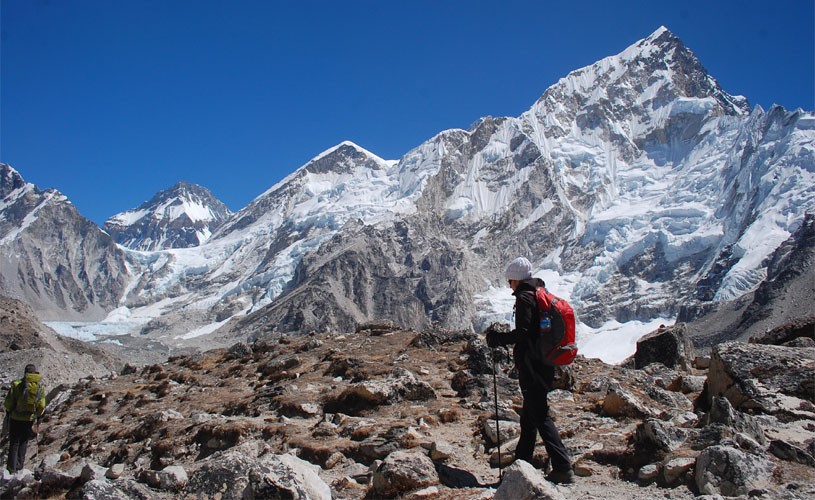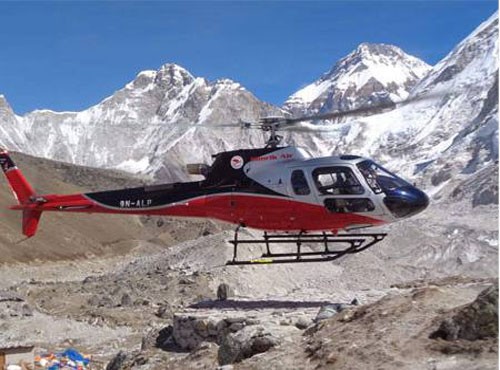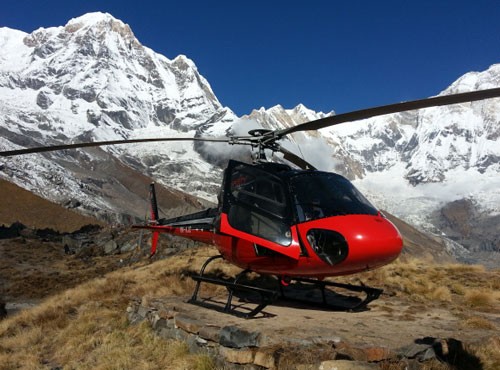Everest Base Camp Trek with Heli Return Highlights:
- Adventure and thrilled packed flight to Lukla, one of the most scenic aerial routes in the world.
- Explore the Sherpa capital of the Khumbu region, Namche Bazaar
- Panoramic views of Everest and other surrounding peaks from Everest View Hotel
- Explore Everest Photo Gallery and Sherpa Culture Museum
- Over a century-old Tengboche Monastery, the largest of its kind in the Khumbu region.
- Amazing views of Lobuche East(6,119m), Lobuche West(6,145m), Taboche Peak(6,367m) Kangtega(6,685m)
- Trek to Everest Base Camp with amazing views of Nuptse, Pumori, Khumbu Glacier, and Khumbutse
- Kala Patthar, the ultimate vantage point for the best view of Everest
- Helicopter ride from Gorakshep to Kathmandu
EBC Trek With Helicopter Return at Best Price For 2025/2026
Everest Base Camp Trek with Helicopter Return is one of Nepal's most exciting aerial journeys. The EBC Trek with a helicopter back is the only way to circumnavigate this iconic landmark.
Everest Base Camp Trek and Return By Helicopter 11 Days is quite popular for people who wish to scale the heights of the Everest region but have limited time and need more time to manage to trek the regular itinerary or luxury during the trek. Flying across Mt. Everest over the soaring Himalayas is a unique experience and an achievement. Our Everest Base Camp Helicopter Trek in Nepal - perfectly incorporates the trekking experience with the luxurious helicopter ride from Gorakshep. Every hiker aspires to visit the base camp of the world's tallest peak, Mount Everest (8,848 meters). Moreover, Everest Base Camp Heli Trekking offers precisely that opportunity in a very short time. One will also have the chance to climb up to Kala Patthar, the ultimate vantage point of the Everest region.
We start our helicopter trip to the Base Camp by flying to Lukla. It is a breathtaking experience in itself. On our way to the Mount Everest Base camp, we pass through the famous Namche Bazaar, Tengboche, Dingboche, Nagerjun, and Lobuche. Before arriving at EBC, we trek through Dingboche, a Himalayan village that offers spectacular views of Mt. Ama Dablam and Mt. Lhotse, among others. During the trek from Dingboche to Nagerjun, we witness amazing views of Lobuche East (6,119m), Kangtega (6,685m), Thamserku (6,608m), and other surrounding mountains.
While the trail from Nagerjun to Lobuche has many luscious meadows, the landscape becomes arid and rocky from Gorakshep. We go to Everest Base camp from Gorakshep, accompanied by astounding mountain views, and return to Gorakshep the same day. The next day, we hike to Kala Patthar and descend back to Gorakshep again. Today, we will take a helicopter ride from Gorakshep over Mount Everest- Khumbu glacier to Kathmandu via Pheriche. The helicopter ride gets you as close to the Everest region and its grand mountains as possible. The Helicopter takes off from GorekShep to Kathmandu via Lukla, where the chopper makes a final halt for refueling before flying to Kathmandu.
Our 11-day Everest Base Camp helicopter Trekking price/cost and itinerary have been designed for limited vacation but average fit trekkers with rest and acclimatizing day in Dingboche. The trek provides an opportunity to experience a fantastic view of mountains from Nangkartshang Hill and get fitness at the higher altitudes. The main highlight of this trek is the 55 to 60 helicopter ride from Gorakshep to return to Kathmandu. This will allow you to replace your trip from the same route with a luxurious helicopter ride.
At Kala Patthar, we enjoy the Massif Himalayan views of the Khumbu Region; taking a dip is highly advised, as the freezing air can adversely affect your body. We will also enjoy the sights of the Khumbu glacier the Icefall region, and the stunning Khumbu Valley during our helicopter trek; EBC Trek and Fly back to Kathmandu by Helicopter is an ideal trip for those who want to experience trekking on Everest and step foot on its major landmarks-Kala Patthar, Everest Base Camp, and Khumbu glacier.
The unique culture of the Sherpas, never-ending suspension bridges, densely forested hills to arid, rocky terrains, chortens, gompas, and monasteries, and the stunning landscape combined with a helicopter ride across the Everest region make this trek a memorable journey. For a shorter helicopter tour of Everest, consider Adventure Club Trek's Everest Base Camp and Gokyo Lakes Tour by Helicopter or Everest Base Camp Helicopter Tour-1 Day.
To book your trip:
Booking the Everest Base Camp trek with a helicopter Return is simple. Just let us know your preferred date and share your details to confirm your booking. We can help you choose the right time for your trip. You can reach out to us via email or phone through social media, as mentioned below.
For 24/7 direct assistance, call Mr. Birendra at +977-9851025658 (WhatsApp and Viber).
You can also contact us via email at [email protected].
For instant booking, click the "Book Now.
Alternatively, visit our Contact Us page Click Here
Hike the Kala Patthar Peak, Everest Base Camp Return by Helicopter
The Kala Patthar summit is a key highlight of the Everest Base Camp trek with a helicopter return. At 5,643 meters (18,514 feet), it offers the best views of Mount Everest and nearby peaks like Nuptse, Changtse, and Lhotse. While Everest's pinnacle isn’t visible from Base Camp, Kala Patthar provides an incredible view of its southwest face. The route starts from Gorak Shep, the final stop before reaching Everest Base Camp and the Kala Patthar viewpoint. The hike takes about 1.5 to 2 hours.
Though only 2.2 kilometers from Gorak Shep, the steep ascent and high altitude make the trek challenging. Many hikers start early to catch the sunrise over Everest, bathing the peaks in golden light, while others prefer sunset views. The summit offers breathtaking views of the Khumbu Glacier and Everest Base Camp below, creating a true “top of the world” feeling. After summiting, trekkers return to Gorak Shep to prepare for the helicopter ride back to Kathmandu. The flight provides a unique aerial view of the Himalayas, soaring over rugged terrain, deep valleys, and icy glaciers—a perfect way to end an unforgettable adventure.
How Difficult Is EBC Trek With Helicopter Return
Everest Base Camp Trek with Helicopter Return, as the name implies, the EBC trek with flyback by helicopter is a beautiful trek to the base of the highest mountain in the world. Trekkers must walk up one way. Hikers will not need to step down after reaching the base camp. Instead, they can fly back in a helicopter, either back to Lukla or Kathmandu, depending on their preferences. EBC Trek is usually a demanding or moderate trek that does not require mountaineering expertise. It is a long hike up to an altitude of 5,364m (17,599ft.), and it seems challenging because you need to walk on days 9th and 10th up to the base camp on varied terrains.
When is the Best Time for EBCTrek With Helicopter Return
It is crucial to monitor the weather before planning the Everest Base Camp Trek with a helicopter return to Kathmandu, as it can determine the success or failure of the trip. The weather is highly unpredictable, with varying conditions throughout the year. While trekking is possible year-round, each season presents its advantages and challenges. The best time for trekking is during the spring and autumn seasons, which offer clear skies and pleasant temperatures. These months provide stunning views of the mountains and a comfortable trekking experience. In contrast, winter and monsoon seasons can make trekking more difficult due to heavy snowfall or rain, combined with colder temperatures, often deterring adventurers.
January to February – Ideal for Adventure Enthusiasts
These are the coldest months, marked by heavy snowfall in the mountains, resulting in extremely low temperatures. Daytime skies are often clear and temperatures manageable, but the nights can be bitterly cold. If you are trekking with Adventure Club Trek, your safety is always a priority. However, if you’re not fond of cold weather, it’s advisable to avoid trekking during this period.
March to April – Best Time for All Trekkers
This is one of the best times to visit Everest Base Camp. The weather is mild, and the views of the Himalayan ranges and glaciers are breathtaking. As spring begins, temperatures become more comfortable, and nature comes to life. Mid-March is particularly ideal, with clear skies and perfect visibility of the snow-capped mountains. Many trekkers achieve their goals during these months.
May to June – Warm and Pleasant Trekking Conditions
The monsoon season begins to approach during these months, but it remains a great time for trekking before the heavy rains arrive. Rainfall generally starts late in June, so trekking in May and early June offers a pleasant experience with warmer temperatures and the beauty of spring transitioning into summer.
July to August – Rainy but Manageable
These are the peak monsoon months, with frequent downpours. Flights to and from Lukla may be canceled due to weather conditions, making the trek more challenging. However, it is still possible to trek during these months. We ensure your safety and will help make the journey enjoyable. Despite the rain, trekkers can still witness spectacular waterfalls, and there are fewer crowds during this season.
September to October – Peak Season for Trekking
This period is another excellent time for the Everest Base Camp Trek, as the monsoon ends and the weather becomes more favorable. Clear skies provide stunning views of the mountains, making it a popular season for trekkers. These months coincide with Nepal's major festivals, Dashain and Tihar, adding a cultural highlight to the trekking experience.
November to December – Cold but Clear Mountain Views
These months bring colder temperatures and the first signs of snow in the higher regions, making trekking more difficult. However, the skies are typically clear, offering beautiful mountain views during the day. Despite the chilly nights, many trekkers still prefer this time for the scenic beauty and tranquility.
Is the 11-day EBCTrek, with a return heli trip, suitable for everyone?
Everest Base Camp Trek with a Helicopter Return is Ideal for individuals with average fitness levels who aspire to reach the popular Everest; this trip is perfect. Even young children can join their parents in this endeavor with relative ease and safety. Comprising a distinctive blend of brief hikes and picturesque flights, this exceptional trip presents a once-in-a-lifetime opportunity. Be sure to become a part of Adventure Club Trek's group to witness the mountains like never before.
We offer just the solution for those seeking a more daring and thrilling trekking experience. There are many alternative routes and options to reach Everest Base Camp. We offer a 13-day Everest Base Camp Trek and a 14-day Short Everest Base Camp Trek. An 18-day trip combining Everest Base Camp with Gokyo Lake Trekking is also available.
Everest Base Camp Helicopter Trek Packing List
Here is some information to help you know what to bring for the trek. It's very important not to forget the essential items because they will affect how comfortable and safe you are. At the same time, try not to carry too much unnecessary gear.
* The Adventure Club Trek will lend each trekker a set of down Jackets, sleeping bags, and duffle bags.
* Our main guide, trained in wilderness first aid, will carry a comprehensive medical kit.
Important Documents and Items
- Valid passport, two extra passport-size photos, and airline tickets.
- Dollars, pounds, or Euros in cash for purchasing a Nepali visa at Kathmandu airport, paying for restaurants and hotels, gratuities, and snacks, and purchasing your drinks and gifts.
- Credit cards, Bank/ATM/Cash machine cards for withdrawing funds from cash machines (bring a photocopy of your cards), traveler's checks, etc
HEAD
- A bandana or headscarf is also useful in dusty conditions
- Warm hat that covers your ears (wool or synthetic)
- Headlamp with extra batteries and bulbs
- Sunglasses with UV protection
- Prescription sunglasses (if required)
- UPPER BODY
- Polypropylene shirts (1 half sleeve and two long sleeves)
- Light and expedition-weight thermal tops
- Fleece wind-stopper jacket or pullover
- Waterproof (preferably breathable fabric) shell jacket
- Down vest and jacket *
- Gore-Tex jacket with hood, waterproof and breathable
LOWER BODY
- Non-cotton underwear briefs
- One pair of Hiking shorts
- One pair of hiking trousers
- One pair of lightweight thermal bottoms (seasonal)
- One pair of fleece or woolen trousers
- One pair of waterproof shell pants, breathable fabric
FEET
- Two pairs of thin, lightweight inner socks
- Two pairs of heavy poly or wool socks
- One pair of Hiking boots with spare laces (sturdy soles, water-resistant, ankle support, "broken-in")
- One pair of trainers or running shoes and sandals
- Cotton socks (optional)
- Gaiters (winter only), optional, "low" ankle high version
HANDS
- One pair of lightweight poly liner gloves.
- One pair of lightweight wool or fleece gloves
- One pair of mittens, consisting of 1 Gore-Tex over mitt matched with a very warm polar-fleece mitt liner (seasonal)
TOILETRIES
- One medium-sized quick-drying towel
- Toothbrush/paste (preferably biodegradable)
- Multipurpose soap (preferably biodegradable)
- Deodorants
- Nail clippers
- Face and body moisturizer
- Female hygiene products
- Small mirror
- Personal Hygiene
- Wet wipes (baby wipes)
- Tissue /toilet roll
- Anti-bacterial handwash
SLEEPING
- One sleeping bag (good to -10 degrees C or 14 degrees F)*
- Fleece sleeping bag liner (optional)
- Rucksack and Travel Bags
- One medium rucksack (50-70 liters/3000-4500 cubic inches, can be used for an airplane carryon)
- One large duffel bag *
- A small daypack/backpack for carrying your valuables should have good shoulder padding.
- Small padlocks for duffel-kit bags
- Two large waterproof rucksack covers (optional)
MEDICAL
- Small, personal first-aid kit. (Simple and light)
- Aspirin, first-aid tape, and plasters (Band-Aids)
- Anti-diarrhea pills
- Anti-headache pills
- Cough and cold medicine
- Anti-altitude sickness pills: Diamox or Acetylpolyamine
- Stomach antibiotic: Ciprofloxacin, Etc. Do not bring sleeping pills, as they are respiratory depressants.
- Water purification tablets or the water filter
- Extra pair of prescription glasses and contact lens supplies.
- Extras/Luxuries
- Reading book
- Trail map/guidebook
- Journal and pen
- Binoculars (optional)
- Voltage converter (from 220 to 110)
- Plug adapter (2 round pegs to 2 flat pegs)
Meals on Everest Base Camp Trek With Helicopter Return
Breakfast, lunch, and dinner — will be provided during the trek, and breakfast will only be provided in Kathmandu. We host welcome and farewell dinners for our guests. During the trek, we have breakfast and dinner at tea houses or lodges where we spend nights while there will be lunch at tea houses on the way. You have the option to choose from Nepali, continental, Tibetan, and Indian cuisines. As we take care of our guests, we ensure that you get healthy food. We prioritize locally produced organic food and provide you with seasonable fruits and hygienically fresh cooked food during the trek.
Note: If you are a vegetarian, let us know in advance so that we can make proper arrangements for food as per your wish during the trek
Accommodation Everest Base Camp Trek With Helicopter Return
During the trip, you will be accommodated in a three-star standard hotel in Kathmandu and a guesthouse/teahouse while on the trek. All accommodations are on a twin-shared basis. A single supplement will be served on request and will cost an additional. Adventure Club Trek will arrange rooms with attached washrooms; however, teahouses in some places only have shared washing and toilet facilities. Also, note that single rooms are readily available in Kathmandu and the trekking regions at lower altitudes, but it might be complicated to find them at higher altitudes.
Drinking-Water Everest Base Camp Trek With Helicopter Return
Adventure Club provides all the meals on the trek but needs to provide water. The best option is to treat the local water with chlorine/iodine tablets or a steripen. The tea houses will give you good quality free water and, you can also get along the trail but, you will need to treat it. If you are using the tablets, make sure they dissolve completely (about 30 mins). On most treks, you can buy mineral water along the trail. A liter of mineral water at lower-elevation tea houses costs around USD 1, but higher elevations can cost up to $4, so the cost can add up.








